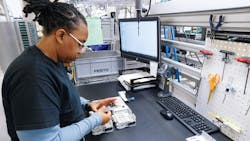Like many industrial automation manufacturers, Festo has weathered and triumphed over the worst of the pandemic supply-chain disruptions. The company was able to advance next-generation products, when certain electronic components weren’t available, and Festo continues to advance its use of supply-chain analytics and to localize is supplier base. The company is a two-part player in the semiconductor industry, as both a consumer of microchips for many of its products, and also a supplier to original equipment manufacturers (OEMs) that build machines for microchip fabrication.
Pandemic woes neutralized
During the worst of the supply-chain issues, Festo experienced extended lead times from suppliers, sometimes dramatic, as well as increased costs, transit disruptions and dramatic shifts in customer demand. In some cases, Festo extended lead times to its customers or helped them reconfigure.
“We invested a tremendous amount of time helping customers find alternatives for products with extended lead times—sometimes in replacement of a Festo part, sometimes in support of challenge from other customer vendors,” says Sean O’Grady, sales operations director at Festo.
Those impacts have mostly been neutralized, says Andrew Sizemore, supply chain director at Festo. “Our delivery has recovered, and our capabilities are back to pre-crisis levels. In fact, in many cases, the lessons learned and tools developed to help us work through the supply-crisis have made us stronger and are now a standard part of our daily operation, as opposed to tools that we’ve put in the proverbial closet to dust off for the next supply challenge,” Sizemore says.
In some cases, overall demand is still feeling the rippling effects from the crisis. “The market is still quite lumpy,” O’Grady says. “Rather than trying to predict how the supply chain will evolve, we’re focusing on accelerating our ability to flex and adapt so that we can continue to stay ahead of the evolution of the markets that we serve and those that serve us.”
Microchip shortage
Festo was most challenged by the lack of electronic components due to the global microchip shortage, as an increasing number of Festo’s products need semiconductors. The biggest shortage challenges came from products that were relatively late in their lifecycles, Grady says. “In some instances, we were able to solve these challenges by accelerating the release of the next generation of that product. We’re also extremely aggressive with our planning for these components and in some cases keep large amounts of safety stock for critical components,” he adds.
Festo is also a supplier to OEMs that build the machines for semiconductor fabrication. Festo supplies these OEMs some standard products, such as pneumatic valves, actuators, ball valves and gates valves, but much of the products for the semiconductor industry are custom (Figure 1). “In some cases, we’re working directly with the semiconductor makers on advancements in process, but most of our sales are to the OEMs that are building the machinery that are used in semiconductor plants,” O’Grady says.
Festo says it is deeply committed to the CHIPS and Science Act, as a supplier and customer of the semiconductor market. “We are currently supporting a wide variety of OEMs as they tool up to equip new semiconductor facilities across the country,” O’Grady says.
“As with any challenge, the lessons we’ve learned over the past few years have made us stronger, more agile and even more closely aligned with our customers,” he adds.
Festo works in a wide variety of industries, so spikes in demand from one industry can be offset by downturns in another. “We also benefit from a lot of intentional knowledge-sharing across industry segments to assure that we’re multiplying solutions from one industry to another,” O’Grady says.
Training sessions on general trends of the industry for the sales force are a regular practice, and industry experts work closely with product experts on new applications-based emerging trends. “They work together to find those opportunities, work through the engineering, prototype them with customers and then share the general results with the rest of the sales force,” O’Grady says.
Localized supplier base
Prior to the pandemic, Festo was already focused on localizing its supplier base, and that accelerated once crisis hit. “We were able to localize more vendors, set up alternate suppliers and reach agreements with customers and suppliers to alleviate risk,” Sizemore says.
This included relationships with new vendors, and Festo strengthened customer relationships with a bigger workforce and better data. “We strengthened our order-management team that focuses on proactive solutions to delivery challenges at the tactical level,” O’Grady says. The teams maintain a delivery forecast map to keep sales teams current on potential supply challenges, so they can guide customers to more readily available products in the early quoting or design phase of the purchasing process.
Festo developed the delivery weather map in-house close to a decade ago, and it has been optimized throughout the years to provide transparent forward-looking information about any product constraints. “This team also proactively monitors existing orders to assure that any possible countermeasures are taken as early in the process as is possible,” O’Grady says.
Demand planners coordinate with product managers about sales expectations. Local sales representatives work with national industry specialists at the customer level and collaborate with product specialists who are dedicated to a specific market and the technical applications of specific products. “We bring all those people together,” O’Grady says. “What are the local customers saying about growth of that product? What is the industry saying about products that are specific to that industry? Where’s the market for that product going in general? And we factor all those pieces of information together.”
Supply-chain analysis
With real-time, interconnected data, Festo demand planners collaborate directly with supply planners. “We’ve accelerated already-planned upgrades to our enterprise-planning software and associated analysis tools. Together, this new suite of tools allows us to consider a much wider variety of inputs into our planning algorithms,” says Julian Torres, demand planning manager at Festo. The company has always considered traditional inputs, such as historical consumption and customer input, but the new system can factor in a wider variety of economic modeling data into the forecast.
“For instance, we know that historical performance of food and beverage OEMs in the Western states has historically aligned very closely with certain economic indexes. While staying mindful of the difference between correlation and causation, we can use future trends in these indexes as an input into overall planning. Once we’ve aligned the demand picture, we rely on our planning software to connect the market expectation into actual production plans,” Torres says.
“The power of data science and real-time data software in supply chain planning is transformational, just as it is in so many other aspects of our society,” Torres says.
About the Author
Anna Townshend
Managing Editor
Anna Townshend has been a writer and journalist for 20 years. Previously, she was the editor of Marina Dock Age and International Dredging Review, until she joined Endeavor Business Media in June 2020. She is the managing editor of Control Design and Plant Services.

Leaders relevant to this article:

